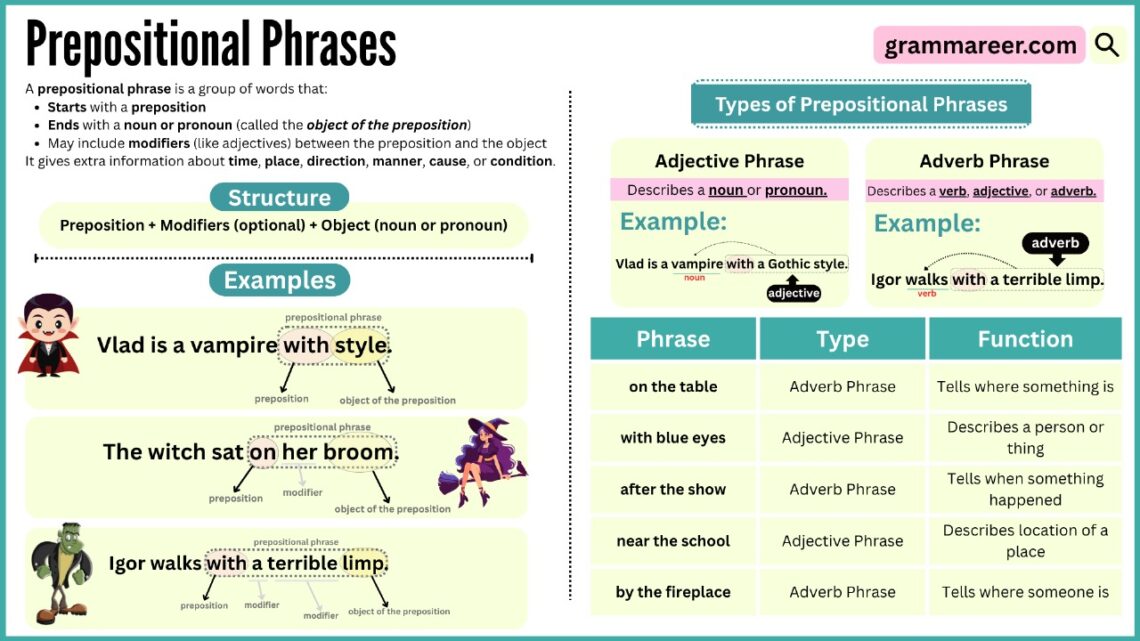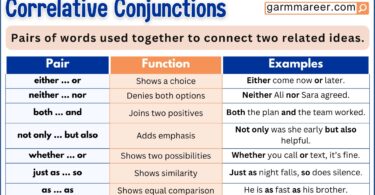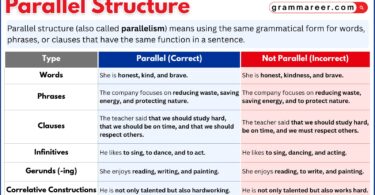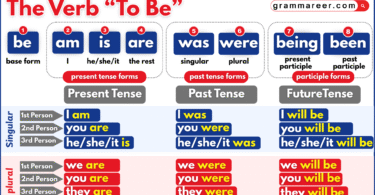Prepositional phrases help us add more info about a noun or a verb — like where something happened, when it happened, or how. They usually start with a preposition (like in, with, or of) and include an object and some extra words.
There are different types of prepositional phrases depending on what they’re describing. In this article, you’ll learn what they are, how to use them, and see lots of examples.
Table of Contents
What are Prepositional Phrases?
A prepositional phrase is a group of words that begins with a preposition and includes its object. It gives more information about people or things like where they are, how they’re connected, or when something happens. In short, it tells us when, where, or how something takes place.
Prepositonal phrases can provide this information to modify a noun, verb, adjectives, or adverb. A prepostional Phrase funcations as an adjective when it modifies a noun. A prepositional phrase works as an adverb when it modifies a verb, adjectives, or adverb.
Prepositional phrases act like adjectives when describing nouns, and like adverbs when describing verbs, adjectives, or other adverbs.
All prepositional phrases have two parts:
- the preposition
- the object of the preposition
The preposition is the word that shows direction, place, time, or relationship (like in, on, or with), and the object is the noun or pronoun that comes right after it.
Example:
- The toy is in the box.
- the phrase “in the box“ is a prepositional phrase. Here, “in“ is the preposition, and “the box“ is the object.

How to use prepositional phrases in sentences?
As we discussed about earlier, prepositional phrases can go at the beginning, middle, or end of a sentence. It all depends on what word or part of speech they are modifying. But there are a few things to keep in mind when using them. Here they are:
- Each sentence needs the right preposition to make a proper prepositional phrase.
- If you use the wrong one, the meaning can totally change—or the sentence might not make sense at all!
- When a prepositional phrase describes a noun, it acts like an adjective.
- But if it adds detail to a verb or action, it works like an adverb.
Prepositional phrases that modify nouns
Whenever a prepositional phrase gives more detail about a noun, it’s called an adjectival phrase—because it’s doing what adjectives do.
Examples:
- The house near the beach is expensive.
- The shoes with blue laces are mine.
- I like the photo on the wall.
Each phrase helps answer questions like which one? or what kind?, making our meaning clearer and more specific.
Prepositional phrases that modify verbs
When a prepositional phrase describes a verb, it’s acting like an adverb because adverbs give more info about actions.
That kind of phrase is called an adverbial phrase.
Examples:
- He ran across the field. (Where did he run?)
- She spoke with confidence. (How did she speak?)
Prepositional phrases acting as nouns
Sometimes, though not very often, a prepositional phrase can act like a noun in a sentence.
Examples:
- Before sunrise is my favorite time to go for a run.
- Without warning isn’t the best way to deliver bad news!
How to avoid too many prepositional phrases?
When writing, it’s tempting to add prepositions to explain every little thing—but too many can make your sentence heavy and hard to follow.
Example:
- Incorrect: In the event of an emergency in the building with the red roof, proceed with caution. (That’s a lot!)
- Correct: If there’s an emergency in the red-roofed building, proceed carefully.
Also, favor active voice to keep your writing strong.
- Incorrect: The cookies were eaten by the kids after dinner.
- Correct: The kids ate the cookies after dinner.
Feels more alive, doesn’t it?
Examples of Prepositional Phrases
Let’s check out how prepositional phrases can be used in everyday sentences.
Using Prepositional Phrases at the Beginning of the Sentence
Starting a sentence with a prepositional phrase can set the scene or give context right away.
- After the meeting, we grabbed coffee.
- During the summer holidays, the kids visited their grandparents.
- In my opinion, this movie is totally underrated.
Using Prepositional Phrases in the Middle of the Sentence
Placing a prepositional phrase in the middle helps describe something more clearly.
- The girl with the blue backpack just transferred here.
- The restaurant near the lake is always packed on weekends.
- The book on the top shelf belongs to my brother.
Using Prepositional Phrases at the End of the Sentence
Ending with a prepositional phrase usually gives extra info or completes the action.
- He placed the keys on the kitchen counter.
- We found a cozy spot under the tree.
- They watched a movie after dinner.
Prepositional phrases List
There are lots of prepositions—over 100! When you pair them with nouns and modifiers, you can create endless prepositional phrases. Let’s look at some common ones, what they mean, and how they’re used.
| Use | Common Prepositions | Conversational Examples |
| Location — where someone or something is | in, on, at, under, over, next to | My phone’s in my backpack. The keys are on the counter. |
| Direction — movement of someone or something | to, toward, through | She walked to the park. The cat darted through the door. |
| Time — when something happens | at, in, on, after, before | We’ll hang out after lunch. I called her before dinner. |
| Manner — how something is done | with, without | He cleaned the room with care. She left without saying goodbye. |
| Instrument — what something is done with | with, without | I fixed it with a paperclip! He managed without any tools. |
| Purpose, reason, or cause — why something is done | for, due to, because of, by | He brought flowers for her. The game was delayed because of rain. |
| Possession or relationship — ownership or connection | of, with | That’s the car of my dreams. A friend with great taste helped me. |
| Source — where something comes from | from | I got this tea from a market in Lahore. |
Why Prepositional Phrases Matter?
Prepositional phrases may seem small, but they help add detail and make your meaning clear. Without them, your sentence can feel flat or even confusing. They tell us things like where, when, or how something happens. So, if you want to sound clearer and more natural, using prepositional phrases the right way really helps.
FAQs
A prepositional phrase is like a helper in your sentence. It has a preposition, its object, and maybe a word that describes it. You can place it almost anywhere, but it can’t stand on its own—it’s just part of the bigger picture.
Here are a few sentences that use prepositional phrases, so you can get a clear idea of how they’re used.
a. The kids are playing in the garden.
b. I put your book on the table.
c. The cat is hiding under the bed.
d. We met at the bus stop.
e. I went shopping with my friends.
f. We went for coffee after the meeting.
g. They built a small cabin by the river.
h. Please don’t talk during the show.
i. There’s a bag between the chairs.
j. We walked over the bridge.
The word of is a preposition, and when you pair it with nouns (and sometimes modifiers), you get a prepositional phrase. It can show different ideas, like:
Possession or relationship – the wheel of my car
Origin – people of ancient Mesopotamia
Material or contents – a shard of glass
About or relating to – I told him of my travels
Final Thoughts
As we learned, prepositional phrases start with a preposition and end with its object. They can’t stand alone, but they help explain where, when, how, or about what something happens. They’re like small helpers that make your sentences clearer and easier to understand.
You May Also Like
Types of Verbs with Examples
What is Noun Phrase?
Types of Nouns in English
Types of Phrases in English




